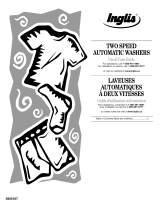
8
Has a fuse blown, or has a circuit breaker tripped?
Replace the fuse, or reset the circuit breaker. If the problem
continues, call an electrician.
Is the washer in a normal pause in the cycle? The washer
pauses for about 2 minutes during certain cycles. Allow the
cycle to continue. Some cycles feature periods of agitation
and soak.
Is the washer overloaded? Wash smaller loads.
Is the lid open? The lid must be closed during operation.
Washer will not agitate or spin with the lid open. On models
with Auto Load Sensing, water fill will not begin with the
lid open.
Washer continues to fill or drain, cycle seems stuck
Is the top of drain hose lower than the control knobs
on washer? The top of the drain hose must be at least 39"
(99 cm) above the floor. See “Drain System” in the Installation
Instructions.
Does the drain hose fit too tightly in the standpipe, or is it
taped to the standpipe? The drain hose should be loose yet
fit securely. Do not seal the drain hose with tape. The hose
needs an air gap. See “Secure the Drain Hose” in the
Installation Instructions.
Washer won’t drain or spin, water remains in washer
Is the drain hose clogged, or the end of the drain hose
more than 96" (244 cm) above the floor? See “Drain
System” in the Installation Instructions.
Is the lid open? The lid must be closed during operation.
Washer will not agitate or spin with the lid open.
Is there excessive sudsing? Always measure detergent.
Follow manufacturer’s directions. If you have very soft water,
you might need to use less detergent.
Wash/Rinse temperature
Are the hot and cold water inlet hoses reversed? See
“Connect the Inlet Hoses” in the Installation Instructions.
Are you washing many loads? As your frequency of loads
washed increases, the water temperature may decrease for
hot and warm temperatures. This is normal.
Did you select a Warm/Warm temperature setting? On
models without AUTO TEMPERATURE CONTROL (ATC) that
do have a Warm/Warm temperature selection, the warm wash
will be followed by an energy saving cold rinse followed by
warm spray rinses. This saves energy while providing the
same rinse performance.
Do you have an ENERGY STAR washer? The wash water
temperatures may feel cooler to you than those of your
previous washer. This is normal.
Clothing Care
Load too wet
Did you use the right cycle for the load being washed?
Select a cycle with a higher spin speed (if available).
Did you wash an extra large load? A large unbalanced load
could result in a reduced spin speed and wet clothes at the
end of the cycle. Evenly distribute the load and make sure the
height of the load does not exceed the top row of basket
holes.
Residue or lint on load
Did you sort properly? Sort lint givers (towels, chenille) from
lint takers (corduroy, synthetics). Also sort by color.
Did you overload the washer? The wash load must be
balanced and not overloaded. Clothes should move freely.
Lint or powdered detergent can be trapped in the load if
overloaded. Wash smaller loads.
Did you select the correct water level? The water level
should be correct for the load size. The load should be under
water.
Did you use enough detergent? Follow manufacturer’s
directions. Use enough detergent to hold the lint in the water.
Did you line dry your clothing? If so, you can expect some
lint on the clothing. The air movement and tumbling of a dryer
removes lint from the load.
Was paper or tissue left in the pockets?
Is your water colder than 60°F (15.6°C)? Wash water
colder than 60°F (15.6°C) may not completely dissolve
the detergent.
Did you use the proper cycle time and agitation speed for
the load? Reducing wash time (duration) and agitation speed
are ways to reduce lint.
Load is wrinkled, twisted, or tangled
Did you unload the washer promptly? Unload the washer
as soon as it stops.
Did you use the right cycle for the load being washed?
Use cycles with shorter wash times and low wash and spin
speeds (if available) to reduce wrinkling, tangling, and
twisting.
Did you overload the washer? The wash load must be
balanced and not overloaded. Loads should move freely
during washing to reduce wrinkling, tangling, and twisting.
Was the wash water warm enough to relax wrinkles?
If safe for the load, use warm or hot wash water. Use cold
rinse water.
Are the hot and cold water hoses reversed? Check to be
sure the hot and cold water hoses are connected to the right
faucets. A hot rinse followed by spin will cause wrinkling. See
“Connect the Inlet Hoses” in the Installation Instructions.
Did you wrap items around the agitator? Drop items
loosely into the washer. Do not wrap items around the
agitator.
Are both the hot and cold water faucets turned on?
Turn on the water.
Is the water inlet hose kinked? Straighten the hoses.
Does the water level seem too low, or does the washer
appear to not fill completely? The top of the agitator is
much higher than the highest water level. This is normal and
necessary for clothes to move freely.
Did you select the 2nd Rinse option (on some models)?
A second rinse may reduce residue or lint on the load.











